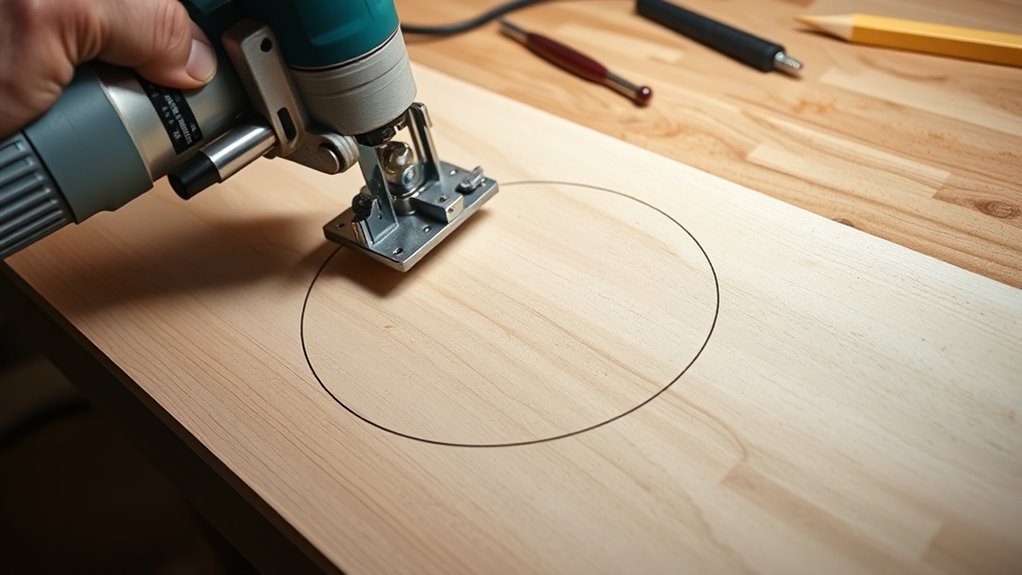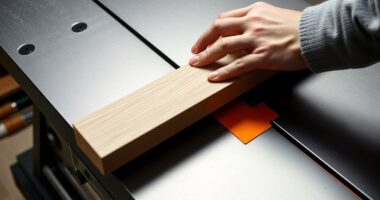To cut perfect circles with a jigsaw, start by securing a circle template of your desired size and tracing it onto your material. Use a fine-toothed, sharp blade, and set your jigsaw to a slow, steady speed. Keep the blade aligned with the guide line, applying gentle, consistent pressure for smooth cuts. Patience and proper technique are key—continue exploring these tips to master perfect circles every time.
Key Takeaways
- Use a sturdy circle template and secure it firmly to ensure precise, consistent outlines.
- Select a fine-toothed, sharp blade appropriate for your material for smooth, clean cuts.
- Set the jigsaw to a slow, steady speed and guide it smoothly along the template line.
- Mark the cut line lightly and follow it carefully, slowing down at the end for a clean finish.
- Practice patience and proper technique to achieve perfect circles of any size every time.

Cutting perfect circles with a jigsaw might seem challenging, but with the right technique, you can achieve smooth, accurate curves every time. The key is to plan your cut carefully and use the right tools to guide your jigsaw along the curve. Start by selecting a circle template that matches the size of the circle you want to cut. These templates, often made of plastic or cardboard, help you trace a perfect outline onto your material, guaranteeing your cut is precise and consistent. Secure the template firmly to your workpiece using tape or clamps, so it doesn’t shift as you cut. This step is essential for maintaining accuracy and preventing wobbling or uneven edges.
Once your template is in place, it’s time to think about blade selection. Not all jigsaw blades are suited for cutting circles, so choose a fine-toothed blade designed for your material, whether it’s wood, plastic, or metal. A blade with more teeth per inch (TPI) provides a cleaner, smoother cut and reduces splintering. For detailed or tight curves, a narrow blade or a scroll saw blade may be more suitable, but if you’re using a standard jigsaw, make sure your blade is sharp and appropriate for the task. A dull blade can cause wobbling, rough edges, and increased frustration, so always replace blades when they become dull.
Next, set your jigsaw to a slow, steady speed. Rushing through the cut can cause the blade to wander off the line or produce jagged edges. As you start, position the blade at the outer edge of the traced circle, then slowly begin to follow the template’s outline. Keep your hand steady and guide the jigsaw smoothly along the curve, maintaining consistent pressure. Use a light touch; pressing too hard can bend the blade and distort your cut. If your jigsaw has variable speed control, dial down to a slower setting for better control and cleaner results.
Throughout the cut, stay focused on the guide line created by your template. It might help to mark the path lightly with a pencil or a marker for added visibility. As you near the end of your cut, slow down even further to guarantee a clean finish. Once you’ve completed the circle, lift the jigsaw carefully away from the material to avoid chipping or splintering the edges. With patience and the right preparation, you’ll find that cutting perfect circles with a jigsaw is well within your reach, giving you professional-looking results every time. Remember, understanding the material properties is crucial for selecting the appropriate blade and technique.
Frequently Asked Questions
Can I Cut Metal Circles With a Jigsaw?
Yes, you can cut metal circles with a jigsaw, but it’s best to use a metal cutting blade for clean results. To guarantee accuracy, secure a circle template or stencil on the metal, and trace your circle before cutting. Use slow, steady cuts, keeping the jigsaw aligned with the template. This method helps achieve smooth, precise metal cutting with your jigsaw, even for complex shapes.
What’s the Best Blade for Cutting Thick Wood?
When cutting thick wood, you want a blade that offers excellent blade compatibility and can handle increased cutting depth. A high-quality, carbide-grit or bi-metal blade works best, providing durability and precision. Make sure the blade’s size matches your jigsaw’s specifications for peak performance. With the right blade, you’ll easily cut through thick wood, ensuring clean, accurate cuts every time, no matter the project size or complexity.
How Do I Prevent Splintering on Delicate Materials?
To prevent splintering on delicate materials, you should use gentle sanding techniques along the cut edges to smooth out roughness. Applying edge sealing before cutting can also help safeguard the surface from splinters. Make sure to use a fine blade and cut slowly, maintaining steady pressure. These steps ensure cleaner cuts and minimize splintering, giving you a professional finish every time you work with fragile or delicate materials.
Is It Necessary to Wear Safety Gear?
You should definitely wear safety gear when using a jigsaw. Protective eyewear keeps your eyes safe from flying debris, while hearing protection shields your ears from loud noise. These precautions help prevent injuries and guarantee you work safely. Always prioritize safety by wearing the right gear, especially when cutting delicate or tough materials. Staying protected allows you to focus on your task and achieve precise cuts every time.
How Do I Repair Jagged Edges After Cutting?
To repair jagged edges after cutting, start with finishing techniques like sanding or filing to smooth out rough spots. Use fine-grit sandpaper or a rasp to gently remove splinters and create a clean, even edge. For more precise edge smoothing, consider applying a router or edge trimmer. Consistent finishing techniques guarantee your project looks professional and polished, making your cut edges safe and visually appealing.
Conclusion
Now you’re ready to cut perfect circles with your jigsaw every time. Think of it like drawing with a compass—you just need the right technique and patience. With a steady hand and these tips, your circles will come out smooth and precise, like a master’s artwork. Keep practicing, and soon it’ll feel as natural as breathing. So go ahead, pick up that jigsaw, and turn your projects into perfect circles effortlessly!









